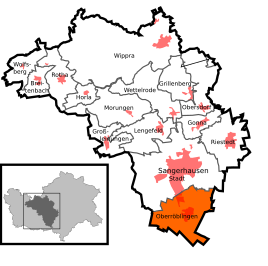Oberröblingen
|
Oberröblingen
City of Sangerhausen
Coordinates: 51 ° 26 ′ 20 ″ N , 11 ° 18 ′ 19 ″ E
|
|
|---|---|
| Height : | 125 m above sea level NHN |
| Area : | 16 km² |
| Residents : | 1557 (Jan. 1, 2013) |
| Population density : | 97 inhabitants / km² |
| Incorporation : | October 1, 2005 |
|
Location of Oberröblingen in Sangerhausen
|
|
Oberröblingen is a district of the city of Sangerhausen in Saxony-Anhalt .
location
The village is located on the Helme directly on the A 38 and A 71 federal motorways as well as the former B 86 and the Sangerhausen – Erfurt railway line .
history
On October 1, 2005, the previously politically independent municipality of Oberröblingen was incorporated into Sangerhausen. In a register of the tithe of the Hersfeld monastery ( Hersfeld's tithe directory ), which was created between 881 and 899, Röblingen is mentioned for the first time together with the other three places with this name as the tithe place Rebiningi in Friesenfeld . That is why the 1100 year celebration was celebrated in Oberröblingen in 1981. Other early mentions date from 1134, 1139 and 1155. In the years 1277 and 1279, Count Friedrich von Klettenberg issued documents in "Rebeningen". Karl Meyer suspected that this Klettenberg count had built a castle here, where he was the last of his family to live after he had sold the remains of the County of Klettenberg and all of his family's imperial fiefs to the Counts of Hohnstein and the other possessions and rights to the surrounding areas Had sold Ilfeld , Kapelle, Kelbra and Walkenried monasteries . Count Friedrich von Klettenberg died after 1279. In the late 13th century, the Counts of Stolberg are now named as the new owners of the castle. How the takeover of Oberröblingen by the Stolbergers took place, which Karl Meyer suspects around 1286, is unknown. However, it is undisputed that the Stolbergers had gained a firm foothold immediately south of Sangerhausen, which was rapidly developing into an important mountain town.
In 1311 the Counts of Stolberg owned the tithe in the corridors of "the villages of Rieth" and in 1316 in "Widenhorst" as a fief of the Bishop of Halberstadt . The income from these villages, which formerly belonged to Voigtstedt County in Stolberg, was subordinated to their Rebeningen castle, for which the name Röblingen or Oberröblingen, which is still in use today, gradually established itself in contrast to Niederröblingen. This resulted in the Röblingen Castle Office, to which the village of Edersleben was moved, half of which the Stolbergers had acquired in 1383 from Count Dietrich and Heinrich von Hohnstein (-Kelbra) for the sum of 376 Mark Nordhäuser currency from the former county of Voigtstedt.
Count Heinrich zu Stolberg regarded Röblingen as an allodial property and offered it as a fief to Landgrave Balthasar of Thuringia in 1392 for reasons that were not yet fully understood . He accepted the offer and undertook that this office, in addition to the offices of Ebersberg and Roßla, should also fall to his daughters on the death of Count Heinrich without leaving any male heirs. This led to an inheritance dispute after Heinrich's death, because the next son of the male line, Count Heinrich (son of Count Otto II zu Stolberg), asserted his claims and took these three offices without objection from the liege lord. His heir, Count Botho zu Stolberg, preferred Hohnstein Castle, which was closer to his possessions, to Röblingen Castle and pledged the latter for 1,000 marks to Messrs Heinrich and Friedrich von Heldrungen and their mother Agnes, including Landgrave Friedrich the Elder. J. von Thuringia gave his consent as a liege lord on November 18, 1417. In return for this he probably received the Heldrunger's half to Hohnstein.
Through the hereditary brotherhood of 1433, the Counts of Hohnstein and von Schwarzburg had a claim to Röblingen in the event that the Stolberg feudal bearers would die out in the male line. Duke Wilhelm of Saxony renewed this claim to the Landtag of Weißensee on January 8, 1446 against Count Heinrich von Schwarzburg. For loyal services, the Duke Count Botho zu Stolberg enfeoffed a few months later, on July 28, 1446, with the court and part of the justice that he had previously possessed as Landgrave of Thuringia in the castle and village of Röblingen. But Röblingen could not be held in the long run by the Stolbergers. After it had been used by the widow of Count Botho alongside Roßla since 1456, Duke Georg von Sachsen certified on March 22, 1504 that Count Heinrich d. Ä. and his two sons Heinrich d. J. and Botho zu Stolberg sold Röblingen Castle with the associated villages, which they previously had as a fief from the duke, due to debts of 14,500 Saxon guilders. Ten years later, on September 13, 1514, the Duke, who was in dire financial straits, left the office and castle to Count Botho zu Stolberg for the sum of 12,000 thalers for six years. The castle office was redeemed by Duke Georg von Sachsen at Michaelis 1520. He incorporated it into his office in Sangerhausen, where it remained until 1815 before the Kingdom of Prussia fell. With the loss of Oberröblingen, the Stolbergers had lost an important economic and political post on an important north-south axis between the Harz and the Thuringian Basin. Today's deserted Weidenhorst was part of the office .
To the west of the village was the Cistercian convent Rohrbach .
Culture and sights
Memorials
- Grave site in the local cemetery for an unknown concentration camp prisoner who died on a death march in April 1945 from the Dora-Mittelbau concentration camp .
Sons and daughters
Erika Arlt was born in Oberröblingen on March 30, 1926, and was awarded the Federal Cross of Merit. Arlt's research areas include the lost train .




